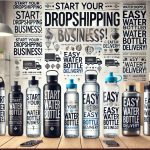The Power of a Money-Back Guarantee
In the competitive market of water bottles, where numerous brands and product variations exist, building customer trust is essential for success. Consumers are more discerning than ever, and the decision to purchase often hinges not just on product quality but on the confidence that a brand offers in its products. One of the most effective ways to instill this confidence is by offering a money-back guarantee.
A money-back guarantee serves as a safety net for customers, reassuring them that if the product doesn’t meet their expectations, they won’t be stuck with something they don’t want or need. This simple yet powerful tool can significantly impact a consumer’s buying decision, improve customer satisfaction, and foster long-term loyalty. In the context of water bottles, where buyers might have concerns about functionality, quality, sustainability, or even the brand’s environmental impact, a money-back guarantee addresses these concerns directly, building trust and enhancing brand reputation.
Building Trust and Reducing Purchase Anxiety
Customer Confidence: The Psychological Benefit
A primary benefit of offering a money-back guarantee is the psychological reassurance it provides to customers. When potential buyers feel uncertain about a product, especially when purchasing online, they might hesitate due to concerns over quality, durability, or whether the product will live up to their expectations. A water bottle, which may seem like a simple item, could still carry concerns about its design, material, safety, or performance.
When customers know that they can return the product for a full refund if they aren’t satisfied, it lowers the perceived risk of making the purchase. This reassurance can lead to increased conversion rates as potential customers are more likely to take the plunge when they know there’s no risk involved. A money-back guarantee makes the buying process feel safer and removes the doubt that could otherwise prevent a sale.
Decreasing Post-Purchase Dissonance
Even after making a purchase, customers often experience a feeling of regret or doubt—commonly referred to as buyer’s remorse. This phenomenon can be particularly common with items that are not an immediate necessity, like water bottles. Perhaps a customer wonders whether they could have found a better deal elsewhere or if the bottle will live up to the claims made by the brand.
Offering a money-back guarantee helps reduce post-purchase dissonance. Customers who feel they’ve made a mistake in their purchase have the security of knowing that they can return the product and recover their money. This can lead to improved satisfaction, even in the event of an initial disappointment. By providing this safety net, brands can maintain a positive relationship with customers, even if they decide the product isn’t quite right for them.
Trust Beyond the Transaction
A water bottle brand that offers a money-back guarantee signals that it is confident in the quality of its products. In an era where many companies focus purely on profits, customers appreciate brands that demonstrate a willingness to stand behind their offerings. It shows that the brand values the customer’s satisfaction over simply making a sale.
For companies focused on sustainability, the guarantee also demonstrates a commitment to the customer experience. For example, a brand offering eco-friendly water bottles might say, “If you’re not satisfied, return the bottle for a full refund—no questions asked,” reinforcing the notion that they value their customers’ experiences as much as they do environmental causes.
Differentiating Your Brand from Competitors
Creating a Competitive Edge in the Market
The water bottle market is vast and increasingly competitive. With numerous brands offering similar products, it can be challenging for companies to stand out. Offering a money-back guarantee gives a brand a unique selling proposition (USP)—a competitive edge that can make all the difference in a crowded marketplace.
This type of guarantee is not only attractive to customers, but it also signals a company’s commitment to customer satisfaction and product excellence. When choosing between two similar water bottles, a buyer is more likely to choose the brand that offers the safety net of a money-back guarantee.
Additionally, for brands that differentiate themselves by offering unique features like BPA-free materials, eco-friendly manufacturing, or ergonomic designs, the guarantee helps reduce any hesitations customers might have about trying a product they’re unfamiliar with. This reassurance can lead to higher conversion rates and increase customer acquisition.
Standing Out in a Price-Sensitive Market
Water bottles, especially mass-produced ones, can often be perceived as commodities. In such a market, price is a key factor in many purchasing decisions. However, competing solely on price can be a race to the bottom, which can hurt a brand’s perceived value and profits.
A money-back guarantee helps justify a higher price point for premium products. For example, if your brand offers a water bottle made from high-quality, sustainable materials that are more expensive than the average plastic bottle, offering a money-back guarantee reassures customers that they are making a wise investment. It makes the price feel less risky and more justifiable, even if the customer is unsure about the purchase.
Enhancing Brand Loyalty and Advocacy
When customers feel that they’ve been treated fairly and that their purchase is risk-free, they are more likely to remain loyal to your brand. They are also more inclined to recommend your product to others, becoming brand advocates in the process. Word-of-mouth marketing, driven by satisfied customers, can be a highly effective tool for increasing brand visibility and building a loyal customer base.
A money-back guarantee encourages this loyalty by creating a sense of customer-centricity. It shows that you are willing to prioritize the customer’s experience and satisfaction. In the long term, this can turn casual buyers into repeat customers, who are not only more likely to purchase again but to share their positive experiences with others.
Managing Customer Expectations
Setting Clear Guidelines for Returns
To ensure that offering a money-back guarantee remains effective and doesn’t lead to abuse, it’s essential to set clear terms and conditions for returns. These guidelines should be easily accessible to customers, ideally on the product page or within the FAQ section. By being transparent about the process, you manage customer expectations and avoid confusion.
For water bottle brands, the terms of the money-back guarantee could include aspects such as:
- Return window: Specify how long customers have to request a return. For example, “Return within 30 days of purchase.”
- Condition of the product: Ensure customers understand the condition the bottle must be in to qualify for a refund (unused, undamaged, etc.).
- Refund method: Clarify whether customers will receive a full refund or a store credit and whether the original shipping fee is refundable.
- Shipping costs: Outline who bears the return shipping costs (this is often the customer’s responsibility, but it should be stated upfront).
Having these conditions in place helps avoid misunderstandings and ensures that your business doesn’t face undue losses from people abusing the guarantee.
Handling Returns and Refunds Efficiently
While it’s important to offer a money-back guarantee, it’s equally crucial that your return process is smooth and efficient. A cumbersome or frustrating return process could negate the positive effect of the guarantee and frustrate customers. On the other hand, an easy and hassle-free return experience can further strengthen your brand’s reputation for customer service.
Here are a few best practices for managing returns:
- Streamline the process: Make it easy for customers to initiate returns. This could include providing a simple return form or allowing customers to print return labels directly from your website.
- Communicate clearly: Keep the customer informed at every step of the return process, from receiving the return request to processing the refund.
- Quick response time: Ensure that refunds or exchanges are processed promptly to avoid delays and customer dissatisfaction.
By managing returns efficiently, your brand demonstrates a commitment to customer satisfaction, which can have a lasting impact on future purchases and customer retention.
Addressing Concerns About Abuse of the Guarantee
One of the primary concerns for businesses when offering a money-back guarantee is the potential for abuse. Some customers may misuse the policy, purchasing a water bottle with no intention of keeping it, simply to get a free product. However, with clear guidelines in place and reasonable limitations, these situations can be minimized.
- Track usage patterns: Keep an eye on any patterns that suggest return abuse. For example, a customer who regularly purchases and returns multiple bottles might need to be flagged for further review.
- Offer exchanges instead of refunds: In some cases, you may want to offer exchanges rather than full refunds. For example, if a customer buys a bottle and later decides it doesn’t meet their needs, offering them a different size or style can resolve the issue without resulting in lost sales.
- Limit the return period: A short return window (e.g., 30 days) can reduce the risk of abuse while still offering customers ample time to test the product.
By finding a balance between customer satisfaction and protecting your business, you can offer a money-back guarantee that benefits both parties.
Legal Considerations and Risk Management
Understanding Consumer Protection Laws
When offering a money-back guarantee, it’s essential to be aware of consumer protection laws in the regions where you operate. Different countries and states may have specific rules and requirements regarding returns and refunds. For instance, some jurisdictions may mandate that certain types of products (like food or personal items) cannot be returned for health or safety reasons.
It’s crucial to research and comply with the relevant laws to avoid potential legal pitfalls. Ensuring that your money-back guarantee aligns with these laws helps protect both your customers and your business.
Managing Financial Risks
Offering a money-back guarantee may initially seem like a risk, especially if your brand faces a high volume of returns. However, with proper risk management and clear terms in place, these risks can be minimized. By tracking return rates, managing customer expectations, and keeping your return process efficient, you can balance the benefits of a money-back guarantee with the financial health of your business.
Moreover, the boost in sales and customer trust often outweighs the occasional returns, especially when customers feel reassured by the guarantee.
Enhancing Customer Satisfaction and Brand Reputation
Positive Word-of-Mouth
When a water bottle brand offers a money-back guarantee, it sends a strong message to customers that their satisfaction is the brand’s top priority. This message is often shared via positive word-of-mouth, which can have a huge impact on your brand’s reputation.
Customers who have positive experiences with returns are likely to share their satisfaction on social media or through online reviews, influencing potential buyers who may be on the fence. A brand with a reputation for excellent customer service and generous return policies can attract new customers who prioritize a positive purchasing experience.
Increasing Customer Retention
Satisfied customers are more likely to return for future purchases. A money-back guarantee can play a key role in retaining customers, as it builds a sense of trust and loyalty. In addition, customers who have had a positive experience with the guarantee are more likely to consider your brand for their next purchase, further strengthening your relationship with them.
Offering a money-back guarantee on water bottles is not just a customer service tactic—it’s an integral part of building trust, enhancing customer satisfaction, and differentiating your brand from competitors. By reducing purchase anxiety, managing returns efficiently, and demonstrating confidence in your product, you can create lasting relationships with your customers that go beyond the transaction.







